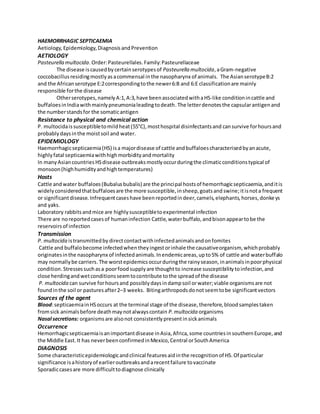
Haemorrhagic septicaemia 9th
- 1. HAEMORRHAGIC SEPTICAEMIA Aetiology,Epidemiology,Diagnosis andPrevention AETIOLOGY Pasteurella multocida.Order:Pasteurellales.Family:Pasteurellaceae The disease iscausedbycertainserotypesof Pasteurella multocida,aGram-negative coccobacillus residingmostlyasacommensal inthe nasopharynx of animals. The AsianserotypeB:2 and the Africanserotype E:2correspondingtothe newer6:B and 6:E classificationare mainly responsible forthe disease Otherserotypes,namelyA:1,A:3,have beenassociatedwithaHS-like conditionincattle and buffaloesinIndiawithmainlypneumonialeadingtodeath. The letterdenotesthe capsularantigenand the numberstandsfor the somaticantigen Resistance to physical and chemical action P. multocidaissusceptibletomildheat(55°C),mosthospital disinfectantsand cansurvive forhoursand probablydaysinthe moistsoil and water. EPIDEMIOLOGY Haemorrhagicsepticaemia(HS) isa majordisease of cattle andbuffaloescharacterisedbyanacute, highlyfatal septicaemiawithhighmorbidityandmortality In manyAsiancountriesHSdisease outbreaksmostlyoccurduringthe climaticconditionstypical of monsoon(highhumidityandhightemperatures) Hosts Cattle andwater buffaloes(Bubalusbubalis) are the principal hostsof hemorrhagicsepticaemia,anditis widelyconsideredthatbuffaloesare the more susceptible,insheep,goatsand swine;itisnota frequent or significantdisease.Infrequentcaseshave beenreportedindeer,camels,elephants,horses,donkeys and yaks. Laboratory rabbitsandmice are highlysusceptibletoexperimental infection There are noreportedcasesof humaninfection Cattle,waterbuffalo,andbisonappeartobe the reservoirsof infection Transmission P. multocida istransmittedby directcontactwithinfectedanimalsandonfomites Cattle and buffalobecome infectedwhentheyingestorinhale the causativeorganism, whichprobably originatesinthe nasopharynx of infectedanimals.Inendemicareas,upto5% of cattle and waterbuffalo may normallybe carriers.The worstepidemicsoccurduringthe rainyseason,inanimalsinpoorphysical condition.Stressessuchasa poorfoodsupplyare thoughtto increase susceptibilitytoinfection,and close herdingandwetconditionsseemtocontribute tothe spreadof the disease P. multocida can survive forhoursand possiblydaysindampsoil orwater;viable organismsare not foundinthe soil or pasturesafter2–3 weeks. Bitingarthropodsdonot seemtobe significantvectors Sources of the agent Blood:septicaemiainHSoccurs at the terminal stage of the disease,therefore,bloodsamplestaken fromsick animalsbefore deathmaynotalwayscontain P.multocida organisms Nasal secretions: organismsare alsonot consistentlypresentinsickanimals Occurrence Hemorrhagicsepticaemiaisanimportantdisease inAsia,Africa,some countriesinsouthernEurope,and the Middle East.It has neverbeenconfirmedinMexico,Central orSouthAmerica DIAGNOSIS Some characteristicepidemiologicandclinical featuresaidinthe recognitionof HS.Of particular significance isahistoryof earlieroutbreaksandarecentfailure tovaccinate Sporadiccasesare more difficulttodiagnose clinically
- 2. The seasonof the year,rapidcourse,and highherdincidence,withfeverandoedematousswellings indicate typical HS. Characteristicnecropsylesionssupportthe clinical diagnosis;confirmationrequires the isolationandcharacterisationof the pathogenusingconventional andmoleculartechniques The incubationperiodvariesfrom3–5 days. In experimental infectionswithlethal doses,cattle orbuffalodevelopclinicalsignswithinafew hours and die within18–30 hours. Morbiditydependsonimmunity andenvironmental conditions,including bothweatherandhusbandry;morbidityishigherwhenanimalsare herdedclosely,inpoorcondition,or exposedtowetconditions. Mortalityisnearly100% unlessthe animal istreatedveryearlyinthe disease;few animalssurvive once theydevelopclinical signs. Antibiotictreatment is effective ifit is started very early,duringthe pyrexic stage. Variousvaccines can provide protectionfor6–12 months Clinical diagnosis Acute or per acute;A fever,dullness, andreluctancetomove are the firstsigns.Salivationandaserous nasal discharge develop,andoedematousswellingsbecome apparentinthe pharyngealregion;these swellingsspreadtothe ventral cervical regionandbrisket. Mucousmembranesare congested Respiratorydistressoccurs,andthe animal usuallycollapsesanddies6–24 hoursafterthe firstsignsare seen.Eithersuddendeathora protractedcourse up to 5 days isalsopossible.Animalswithclinical signs,particularlybuffalo,rarelyrecover. Chroniccasesdonot seem to occur Buffaloesare generallymore susceptible toHSthancattle and show more severe formsof disease with profoundclinical signs. Inendemicareasmostdeathsare confinedtooldercalvesandyoungadults Massive epizooticsmayoccurin endemicaswell asnon-endemicareas. Inthe recentpast,HS has been identifiedasasecondarycomplicationincattle andbuffalosfollowingoutbreaksof footandmouth disease (FMD).Case fatalityapproaches100% if treatmentisnotfollowedatthe initial stage of infection Lesions Widespreadhaemorrhages,oedema,andhyperaemia,consistentwithsevere sepsis. Oedemaconsists of a coagulatedserofibrinousmasswithstraw-colouredorbloodstainedfluid. Swellingof the head, neck,and brisketoccursinnearlyall cases.Similarswellingscanalsobe foundinthe musculature Subserosal petechial haemorrhagesmayoccurthroughoutthe body,and the thoracic andabdominal cavitiesoftencontainblood-tingedfluid Scatteredpetechiae maybe visible inthe tissuesandlymph nodes,particularlythe pharyngeal andcervical nodes;thesenodesare oftenswollenandhemorrhagic Pneumoniaorgastroenteritisoccasionallyoccurs,butusuallyisnotextensive. Atypical cases,withnothroat swelling andextensive pneumonia,are sometimesseen. Thereare no microscopicfeaturesthatare specificforhemorrhagicsepticaemia –all lesionsare consistentwith severe endotoxicshockandmassive capillarydamage Differential diagnosis ShippingfeverisoftenmistakenlyconfusedforHS,buthas a multifactorial aetiology(oftenMannheimia haemolytica),isnotsepticaemic,anddoesnotcause multisystemicpetechial haemorrhages The peracute nature of the disease andthe extensive oedemaandhaemorrhage make itdifficultto differentiatefromblacklegandanthrax. Acute salmonellosis,mycoplasmosis,andpneumonicpasteurellosisshouldalsobe considered Laboratory diagnosis Samples P. multocida isnot alwaysfoundinbloodsamplesbefore the terminal stage of the disease,andisnot consistentlypresentinnasal secretionsorbodyfluidsof sickanimals. Infreshlydeadanimals,a heparinisedbloodsampleorswabshouldbe collectedfromthe heartwithinafew hoursof death,and a nasal swab. A longbone shouldbe takenfromanimalsthathave beendeadfora longtime.Other visceral organsmayalso be sampled if anecropsyisnot feasible,bloodsamplescanbe takenfromthe
- 3. jugularveinbyaspirationorincision;bloodsamplesshouldbe placedinastandardtransportmedium and transportedonice packs.Spleenandbone marrow provide excellentsamplesforthe laboratory,as these are contaminatedrelativelylate inthe post-mortemprocessbyotherbacteria. Tipsof ears(from live animal only) Procedures Identificationofthe agent Serological tests Serological testsare notnormallyusedfordiagnosis;however,hightitres(1:160or higherby indirect haemagglutination) insurvivingin-contactanimalsare suggestive of the disease For more detailedinformationregardinglaboratorydiagnosticmethodologies, PREVENTION AND CONTROL Sanitaryprophylaxis Vaccinationisroutinelypracticedinendemicareas.Avoidingcrowding,especiallyduringwetconditions, will alsoreduce the incidence of disease. Medical prophylaxis Antimicrobialsusceptibilitytesting(AST) isparticularlynecessaryfor P.multocida forwhichresistance to commonlyusedantimicrobial agentshasoccurred The followingagentshave proventheirclinical efficacy:penicillin,amoxicillin(orampicillin), streptomycin,gentamicin,spectinomycin,florfenicol,tetracycline,sulfonamides, trimethoprim/sulfamethoxazole,erythromycin,andnorfloxacin Inactivatedvaccines Vaccination is routinely practiced in endemic areas Three preparationsare used – dense bacterinscombinedwitheitheralumadjuvantoroil adjuvant,and formalin-inactivatedbacterins;the oil adjuvantbacterinisthoughttoprovide protectionforupto one yearand the alum bacterinfor4–6 months Maternal antibodyinterfereswithvaccine efficacyincalves Live attenuated vaccines A live HSvaccine preparedusinganavirulentP.multocidastrainB:3,4(Fallow deerstrain) hasbeenused for control of the disease incattle andbuffaloesover6monthsof age inMyanmar since 1989; it is administeredbyintranasal aerosol application(atrial of the vaccine hasbeencompletedinIndonesia). PUBLIC HEALTH There are noconfirmedreportsof humaninfectionswithP.multocidaserotypesB:2andE:2; however, otherserotypesdocause humaninfectionsandprecautionsshouldbe takentoavoidexposure